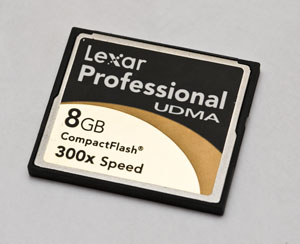An important characteristic of memory cards is generally known as "speed" and, in general terms, represents the rate at which data can be transferred to and from the media. As with other digital media, such as CDs and DVDs, there is a limit to the rate at which data may be written or read.
Some card manufacturers quote speed in terms of the number of megabytes of data that can be transferred per second. Others used the old multiplication ("x") factor familiar to those working with CDs and DVDs. "1x" represented a transfer rate of 150KB/sec, "2x" represented 300KB/sec, and "10x" represented 1.5MB/sec etc. A third system, known as the class system, quotes minimum sustained data transfer speeds (DTS) as classes - ie Class 2 represents a minimum transfer speed of 2MB/sec and Class 6 represents a minimum transfer speed of 6MB/sec.
 All the above systems are intended to provide only a general measure of data transfer speed. The actual speed of data transfer depends upon a number of factors including the extent to which the card is fragmented. The transfer speed for a clean formatted card is normally higher than that of a similar card on which a number of images have already been stored.
All the above systems are intended to provide only a general measure of data transfer speed. The actual speed of data transfer depends upon a number of factors including the extent to which the card is fragmented. The transfer speed for a clean formatted card is normally higher than that of a similar card on which a number of images have already been stored.
It is worth noting that not all cameras are designed to take advantage of high-transfrer-rate cards. The highest speed cards, often labelled "extreme" are expensive and intended for use with high-end amateur DSLRs or professional, cameras that may be used to shot large, high resolution images often in RAW mode. in RAW format or high res JPEG format. Individual image files may be 30MB or more, so very high data transfer rates help to maintain optimum continuous shooting frame rates. As with any serial process, overall system speed tends to be limited to the speed of the slowest section. There is no point in buying fast memory cards for a camera that cannot supply data at the maximum speed rating of the card. Equally, a fast camera can be severely speed limited by using cheaper and slower memory cards.
When reading data from a memory card to another device, such as a PC, high data transfer rates obviously reduce the time required - particularly when uploading large numbers of images. However, the card reader and the associated connections must also feature suitably high specifications.






